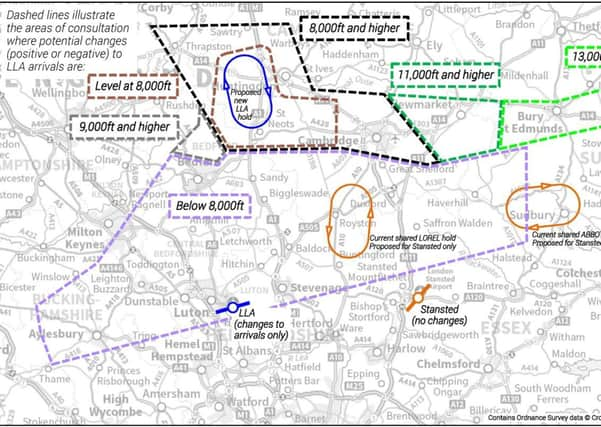Fears NATS preferred flight path plan could have significant impact on Leighton Buzzard


Currently, LLA and Stansted, which are two of the five busiest airports in the UK, share the same arrival flows to the same holds, in a relatively small region. As it is so interdependent, air traffic control often has to limit the number of aircraft in this airspace to maintain safety, which causes delays.
The joint consultation, co-sponsored by LLA and National Air Traffic Control Services (NATS), is proposing a new holding stack over Grafham Water near Huntingdon solely for Luton arrivals. Easterly Operations (30 per cent of arrival flights) from here concern Leighton Buzzard with two options up for discussion.
Advertisement
Hide AdAdvertisement
Hide AdThe first option seeks to establish a new airborne hold, or stack, for LLA arrivals, with associated airspace and air routes, above approximately 8,000ft. From that new hold, the method air traffic controllers use to bring arrivals from 8,000ft to the runway would be similar to today - providing each aircraft with heading, descent and speed instructions, manually managing each flight (known as vectoring). This reduces complexity and minimises the change from today’s flight paths at lower altitudes.
The second option - the preference of NATS, also seeks to establish a new airborne hold, or stack, for LLA arrivals, with associated airspace and air routes, at 8,000ft and above. From that new hold, air traffic controllers would still use the vectoring method described in the first option, to descend aircraft to the runway. However, there would also be a number of predetermined arrival flight paths which aircraft could fly automatically and without intervention by controllers.
The Leighton Buzzard Society is in favour of option one. Transport officer John Sharp said: “Option one starts from a point southeast of St Neots with a swathe approx 10 miles wide narrowing to about 3.5 miles approaching Leighton Buzzard with flights passing to the south of the built up area. At this point aircraft would be flying level at 5,000ft. We are told in the consultation that some 70 per cent of these flights would be vectored to final approach and the remainder would be given shortcuts arriving from several directions.”
Mr Sharp thinks that vectoring gives a wider spread of aircraft movements. His view is shared by the Vale of Aylesbury consultee body to the LLA Consultative Committee People Against Intrusive Noise (PAIN). Chair David Godfrey said: “The choice is between all of the planes going south of Leighton Buzzard but spread over a wide swathe, and the planes being split north/south of the town but over, in the main, narrow ground tracks.
Advertisement
Hide AdAdvertisement
Hide Ad“I would guess that option two would generate more complaints from residents. I would also think that there are more residents living close to the northern option than the southern one, but maximising annoyance reduction from option one will depend on the quality of the vectoring to ensure that the same route is not flown by default.”
MP for South West Bedfordshire Andrew Selous also supports option one. He said: “In recent years LLA has managed to fly less aircraft over Leighton Buzzard than in the past and I have had less complaints from constituents as a result.
“I am pleased that both the options avoid flying directly over the town, and from the information provided it appears that option one will spread the flights more widely, thus causing less disturbance to the same people which seems preferable.”
NATS says that some communities overflown by Luton arrivals will be positively or negatively impacted. Option two is their preference because it aligns with the principles of the government’s Airspace Modernisation Strategy, more than option one.
Advertisement
Hide AdAdvertisement
Hide AdNATS also thinks option two would provide a predictable, equitable distribution of air traffic and would improve resilience should disruptive events occur such as the weather.
Lee Boulton, from NATS, said: “The pandemic has of course drastically reduced the number of flights using not only LLA, but all airports in the UK these past months. However, work on this proposal started in 2017 and is driven by the underlying safety requirement to reduce the region’s airspace complexity and will still be necessary even if air traffic recovers from the effects of the coronavirus pandemic more slowly than predicted.”
Neil Thompson, operations director at LLA, said: “Thanks to our virtual exhibition, it has never been easier to participate in such an important consultation. While we have been pleased by the overall response so far, we are keen to hear from as many communities as possible. With just two weeks to go, we urge everyone living or working in Bedfordshire, Hertfordshire, Buckinghamshire, Cambridgeshire, Essex and Suffolk to use the illustrative online postcode tool and see what the proposals may mean for you and provide your feedback before the deadline.”
To find out more and submit a response, visit https://www.nats.aero/vr/ad6
Advertisement
Hide AdAdvertisement
Hide AdThe consultation closes on February 5, responses should be made using the form on the Civil Aviation Authority website: https://consultations.airspacechange.co.uk/london-luton-airport/ad6_luton_arrivals
Leighton-Linsdale Town Council’s Planning and Transport Committee will discuss the consultation at their next meeting on Wednesday, January 27, at 7.30pm.
What do you think about the proposals? Email news@lbobserver.co.uk